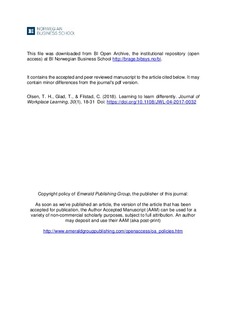Learning to learn differently
Journal article, Peer reviewed
Accepted version
Permanent lenke
http://hdl.handle.net/11250/2500033Utgivelsesdato
2018Metadata
Vis full innførselSamlinger
- Publikasjoner fra CRIStin - BI [1015]
- Scientific articles [2181]
Sammendrag
Purpose:This paper aims to investigate whether the formal and informal learning patterns of community health-care nurses changed in the wake of a reform that altered their work by introducing new patient groups, and to explore whether conditions in the new workplaces facilitated or impeded shifts in learning patterns.
Design/methodology/approach: Data were collected through interviews with experienced nurses in community health care to learn whether and how they changed their learning patterns and the challenges they experienced in establishing new work practices.
Findings: In established learning patterns among nurses, the most experienced nurse passes on the knowledge to novices. These knowledge boundaries were challenged and they created new contexts and tasks calling for more cross-disciplinary cooperation. The informants acknowledged the need for formal and informal learning activities to change their learning pattern in addressing new knowledge challenges. Structural and cultural factors in community health care impeded changes in individual and collective learning patterns.
Research limitations/implications: This paper reports a single case study. Further study is needed on how changes in structural and contextual conditions challenge the established formal and informal learning patterns.
Practical implications: It is crucial that managers facilitate the development of new routines, structures and cultures to support individual initiatives and the growth of necessary changes in established practice to implement a new reform.
Originality/value: This study’s contribution to the literature primarily concerns how changes in structural conditions challenge formal and informal learning patterns, and the structural and cultural conditions for these learning patterns.
